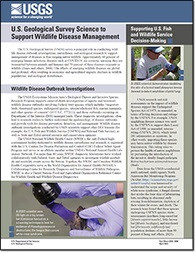
Product Details
- Product Number
- 534193
- Series
- FS-2022-3073
- Scale
- NO SCALE
- Alternate ID
- FS-2022-3073
- Authors
- CHRISTINE L DENSMORE
- Version Date
- 08/01/2022
- Countries
- USA
- Media
- WEB ONLY
- Format
- WEB ONLY
Additional Details
- Description
-
Eastern Ecological Science Center — Fish and Aquatic Animal Health
This product is not available for order, it can only be downloaded from here (click on image) or within the Publications Warehouse at https://pubs.er.usgs.gov/publication/fs20223073
First posted September 7, 2022
For additional information, contact:
Director, Eastern Ecological Science Center
https://www.usgs.gov/centers/eesc
U.S. Geological Survey
11649 Leetown Road
Kearneysville, WV 25430
Abstract
Science provided by the U.S. Geological Survey (USGS) Eastern Ecological Science Center (EESC) helps to protect fish and aquatic animal health and support disease management of our Nation’s fisheries and aquatic animal populations. Our capabilities and expertise span diverse, yet highly integrated disciplines related to all aspects of biology, ecology, and animal health. Our scientists work to identify novel and emerging pathogens and diseases to assess fish and aquatic animal responses to parasites, pathogens, adverse environmental conditions, and chemical exposures. Eastern Ecological Science Center research is conducted both in laboratories and in the field in various aquatic environments ranging from headwater streams to the ocean. The EESC team provides science leadership and support for fisheries and aquatic species specialists nationwide.
- Survey Date
- 2022
- Print Date
- 2022
- Height In Inches
- 11.000
- Length In Inches
- 8.500
- Languages
- English





